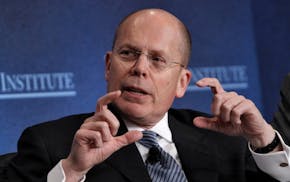A new survey by the Federal Reserve Bank of Minneapolis shows deepening concerns about the health of residential and commercial construction companies in the Fed's six-state region, while companies that build industrial and infrastructure projects are more optimistic.
Across all sectors, however, the industry is seeing some improvements as labor becomes more available, supply-chain issues that have vexed construction companies improve and price inflation moderates.
"It's nice to see that we can now get products and trade partners," said Shane LaFave, executive vice president at Roers, a Twin Cities-based apartment developer. "People are hungrier and are looking for work."
LaFave said the timing delays that dogged developers are going away and that lower labor costs have helped offset some of the higher borrower costs that developers now face.
"The pendulum swings back and forth, but we're probably more in the middle," he said, noting that many developers are pulling back on new projects. That's not the case for Roers, which plans to keep developing apartments.
The Fed is in a blackout period until the next Federal Open Market Committee meeting next week, so beyond the initial survey results Fed economists were unable to comment directly.
During the survey presentation Nov. 29, Ron Wirtz, a Minneapolis Fed Regional Outreach director who tracks business conditions for the construction industry, highlighted some notable changes since previous surveys, most notably that the situation for the residential sector is worsening by a "sizable margin" and that the industrial and infrastructure sectors are also showing signs of weakness as the number of new projects wanes and backlogs shrink.
The survey provides a high-level glimpse into the psyche of companies in the four key sectors of the construction industry, which has been an economic driver through the tumult of the COVID-19 pandemic and all the uncertainties that came with it.
The survey was conducted in early November in partnership with dozens of construction and other trade organizations and is based on the responses of 311 business leaders who rated their expectations for what's to come over the next several months in key business categories.
The majority of those in the residential and commercial construction sectors — companies that build housing, offices and commercial buildings — said revenue had fallen. The opposite was true for those that focus on industrial and infrastructure projects, including roads and bridges.
In the residential sector, 46% said they don't expect business to improve, but those in the infrastructure sector had the most promising outlook, with 48% expressing optimism. Nearly 40% of the commercial companies that responded were optimistic, while slightly fewer were pessimistic. The remaining responses were neutral.
The outlook is most gloomy for homebuilders who are concerned that new work may soon run out, with 67% saying their project backlog was waning and 60% saying they were receiving fewer requests for proposals from private clients.
Revenue was down for 61% of the respondents in the residential sector compared with 41% of those in the commercial sector and only about a third of those that work on industrial and infrastructure projects.
For companies that build houses, the tipping point was rising mortgage rates. They became more pessimistic than those in other sectors toward the middle of 2022 as mortgage rates rose, according to previous Minneapolis Fed surveys.
That waning sentiment among residential and commercial builders is consistent with local reports that show declining demand for both new houses and office buildings.
Earlier this week, Housing First Minnesota released a November report that showed recent gains for single-family construction but that residential construction this year was down significantly compared with 2022.
From January through November, the total number of permits, including single-family houses and rental apartments, was down 36% compared with last year.

Hundreds line up at Best Buy to nab Nintendo Switch 2, in scene like '90s opening parties

UnitedHealth shareholders give tepid support to $60M in stock-based pay for new CEO
Target recalls more employee groups to downtown Minneapolis headquarters

Ronzoni pasta-maker coming to Lakeville in $880 million Post acquisition
